The majesty of Grand Teton National Park is undeniable. The sheer rock faces seem to burst out from the open plains of Wyoming forming an aggressive and unmistakable sawtoothed silhouette. I’ve been there a handful of times during warmer months and now I’ve been lured back during the “dead” of winter. But if you ask me, the Tetons are anything but “dead” when the cold winds of January blow. The lush June fields of wildflowers are long gone, but they’ve been replaced by a pure white blanket of snow that glistens in the sun like a million diamonds. It’s a marshmallow world in the winter, and all of that white illuminates the landscape in amazing ways, lending strength to starlight for pre-dawn snowshoe sessions.
We drove into Jackson through a formidable storm that would give pause to anyone thinking about braving the 4+ miles of 10% grade in Teton Pass. I’ve got new tires, I’ve got all-wheel drive, and I’ve got a whole bunch of faith in my vehicle, so we took the pass and made it into Jackson slowly and safely.
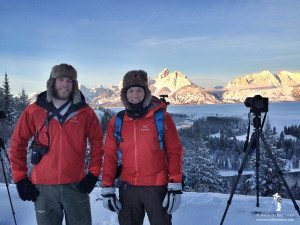
Dawn would reveal the valley in a fresh coat of the white stuff with wreaths of fog and occasional low-lying clouds. I had pre-visualized a shot from the classic Snake River Overlook with peaks illuminated by the warmth of sunrise set against a pink sky. After an early wakeup, I bundled up in several layers of clothes and drove out to the overlook. The parking area had not been plowed recently, and I soon found myself trying to walk slowly and gingerly across the snow, as if somehow the way in which I walked would make me light as a feather. I wasn’t even close to featherweight, as one leg would suddenly plunge waste deep into several feet of untouched snow. It was foolish to leave the snowshoes in the car, but I sure wasn’t going to take 2 minutes to go back and get them. As dawn approached I found myself in the company of a couple other individuals, but certainly much less that I’ve seen there during summer or autumn – one of them even appeared to be my long lost twin…
I was pleased when the pre-dawn “Belt of Venus” light cast deep pink and purple hues in the western sky. Though it wasn’t just the sky that was colored in pastel – the snow, the trees, and especially the river below all took on the soft, cool hues of dawn. The pink Belt of Venus glow was just the beginning of the show that morning, for as the sun crested the hills to the east it threw a warmer golden glow upon the mountains. At first it just lit up the very tips of the peaks, but in a matter of minutes the golden light had worked its way down almost to the valley floor before it changed, its quality hardening and losing that glowing golden hue.
I struggled with this image – the one you see at the start of this post – because I wanted the best of both worlds. I wanted the photo to reflect my experience that morning, from the pink and purple hues of the Belt of Venus to the fiery golden light that shone upon the snowcapped peaks. Once I was back in the comfort of my home and had a good look at the images from that morning, I decided to combine the best of both scenes to create the image you see above. Here are the two images I used, which were taken only 14 minutes apart.
When the good sunrise light had peaked, I started packing my bag and made my way gingerly back to the car. It is difficult to leave such a beautiful location, even when I know I have already witnessed the best light of the day. Driving back along the highway I kept my eyes peeled for any sights that might be especially photogenic that morning. When I came up to the Antelope Flats area I could see in the distance a stand of cottonwoods that were shining brilliantly, backlit by the sun. I made the turn and drove up the road to investigate, and when I came closer to those cottonwoods I was practically jumping for joy. Well, inside I was jumping for joy, and on the outside I was hurriedly and silently unpacking my gear and trying to setup the tripod before the sun rose higher above the branches. Not only were these cottonwoods flocked with frost – they were backlit by the sun AND they were wreathed in mist. The trunks cast long dramatic shadows and the branches were alight in the morning sun. As quickly as possible I leveled the tripod, threw on my 70-200mm lens and started photographing a 14 image panorama. That telephoto focal length really helped to compress the scene and bring those distant trees closer. Finally, I felt that the drama of those long shadows really lent this image to a black and white conversion.
Here are some more images from that morning…because I can’t share just one! The best part about this set of images is that they are UNIQUE compositions – something which is next to impossible at the Snake River Overlook.
 I had one more opportunity to photograph sunrise on this trip. It was such an incredibly clear, still morning on the Antelope Flats when I stepped out of my vehicle and onto the crunch of ice covered snow. The previous days warm temperatures and precipitation had formed a frozen crust over several feet of snow – a crust that would at times support my entire weight and other times fall away below me in large chunks exposing the soft snow below it. I had chosen Mormon Row as the subject for this sunrise, and I foolishly strapped on my snowshoes despite the fact that I had cross-country skis available. The Antelope Flats Road is only halfway plowed – the rest becomes a winter trail used by snowmobiles, snowshoers, and skiers. The snowshoeing was tough work, plodding along in the dark – crunch crunch crunch through the snow, one foot at a time. That slow-going difficulty of snowshoeing didn’t really matter though – the tiresome aspects of the hike melted away below the pre-dawn sky. Morning was coming, evidenced by the black of night giving way to a deep cobalt blue that was still studded by a million stars. The air seemed so clear, and so crisp – this may have been a perception fueled by the sting of the frigid air blowing through my lungs, or it could just be the truth of what pulls us out of our warm homes on mornings like this – that fresh, open country air. It’s the same kind of air the fur trappers and pioneers were breathing in the 19th century, and the same air the Native Americans were breathing for thousands of years before that. It’s the air of those special open places far from the clangor of city life.
I had one more opportunity to photograph sunrise on this trip. It was such an incredibly clear, still morning on the Antelope Flats when I stepped out of my vehicle and onto the crunch of ice covered snow. The previous days warm temperatures and precipitation had formed a frozen crust over several feet of snow – a crust that would at times support my entire weight and other times fall away below me in large chunks exposing the soft snow below it. I had chosen Mormon Row as the subject for this sunrise, and I foolishly strapped on my snowshoes despite the fact that I had cross-country skis available. The Antelope Flats Road is only halfway plowed – the rest becomes a winter trail used by snowmobiles, snowshoers, and skiers. The snowshoeing was tough work, plodding along in the dark – crunch crunch crunch through the snow, one foot at a time. That slow-going difficulty of snowshoeing didn’t really matter though – the tiresome aspects of the hike melted away below the pre-dawn sky. Morning was coming, evidenced by the black of night giving way to a deep cobalt blue that was still studded by a million stars. The air seemed so clear, and so crisp – this may have been a perception fueled by the sting of the frigid air blowing through my lungs, or it could just be the truth of what pulls us out of our warm homes on mornings like this – that fresh, open country air. It’s the same kind of air the fur trappers and pioneers were breathing in the 19th century, and the same air the Native Americans were breathing for thousands of years before that. It’s the air of those special open places far from the clangor of city life.
I reached the T.A. Moulton barn with plenty of time before sunrise. I took my time setting up my tripod, choosing the right lens, the right focal length, and framing the shot. The land grew lighter and lighter as the sky paled before a rising sun and that’s when I saw movement – there were two humans making their way down the snow-covered road where I had plodded along in my snowshoes. But these two weren’t plodding – they were gliding – on skis! I felt foolish for opting for snowshoes over skis that morning, but it is always good to come away from a shoot with a few lessons learned, even if they aren’t photography related.
Speaking of lessons, I learned that since the sun rises a bit further south in winter, the first moments of sunrise are blocked by the distant foothills in the Antelope Flats. I never really got to see that shining golden light on the barn that morning – due either to clouds or the hills – and likely a combination of both. Below is my panorama from the experience, one that is just an “alright” photo in my opinion – it didn’t quite fulfill what I had envisioned that day. But that’s okay, because I still had a great time, and I didn’t miss the show that happened behind me – for as the sun rose, the clouds to the east lit up like wildfire and I felt like I was the only person in the world to see it.

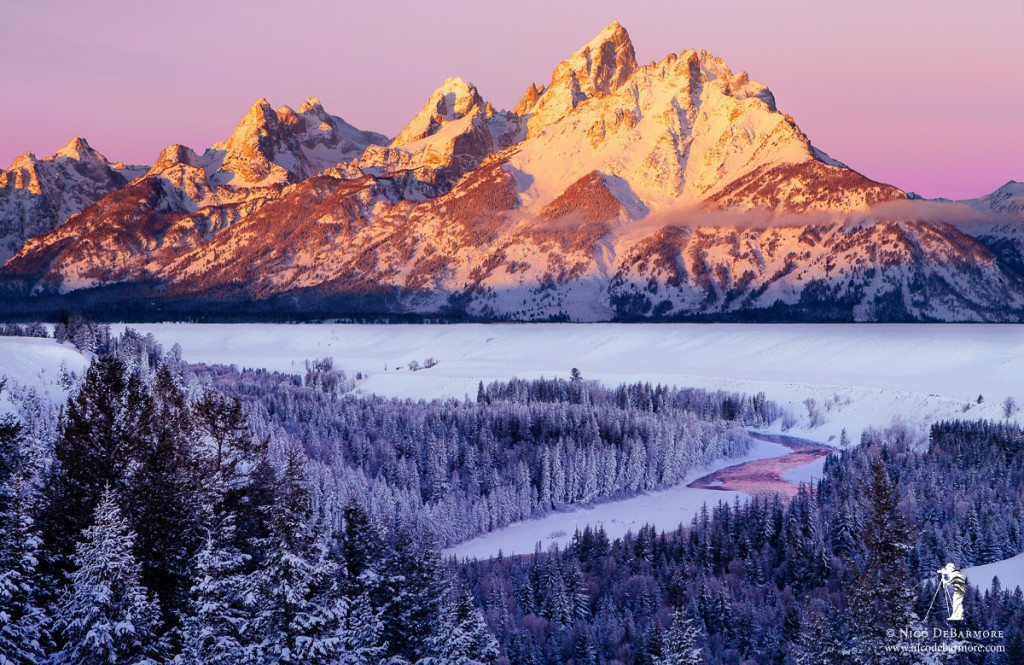
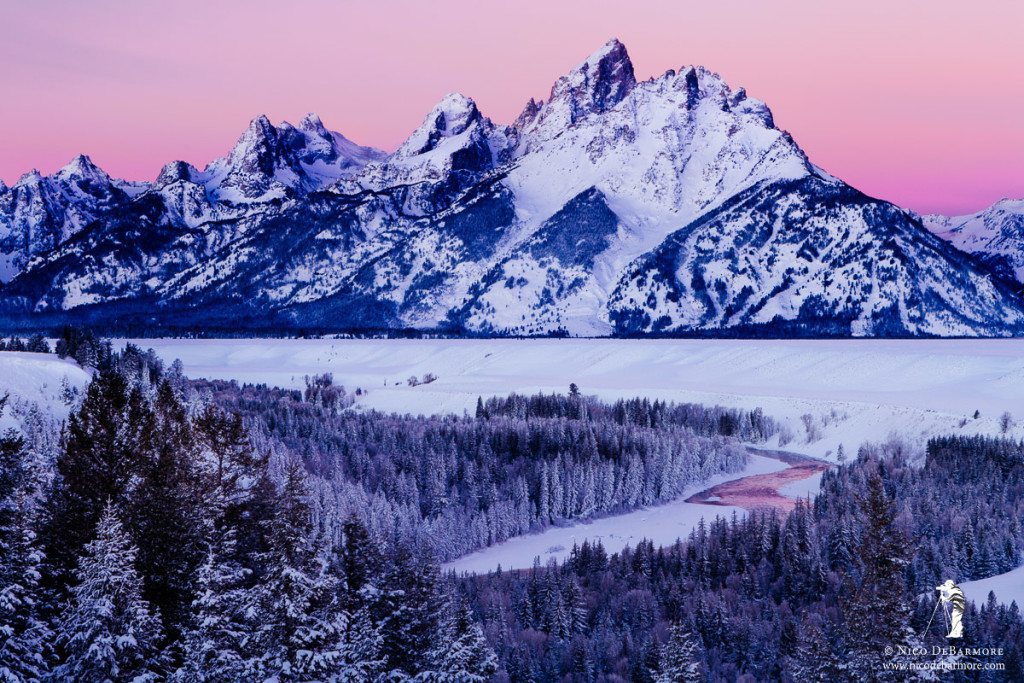
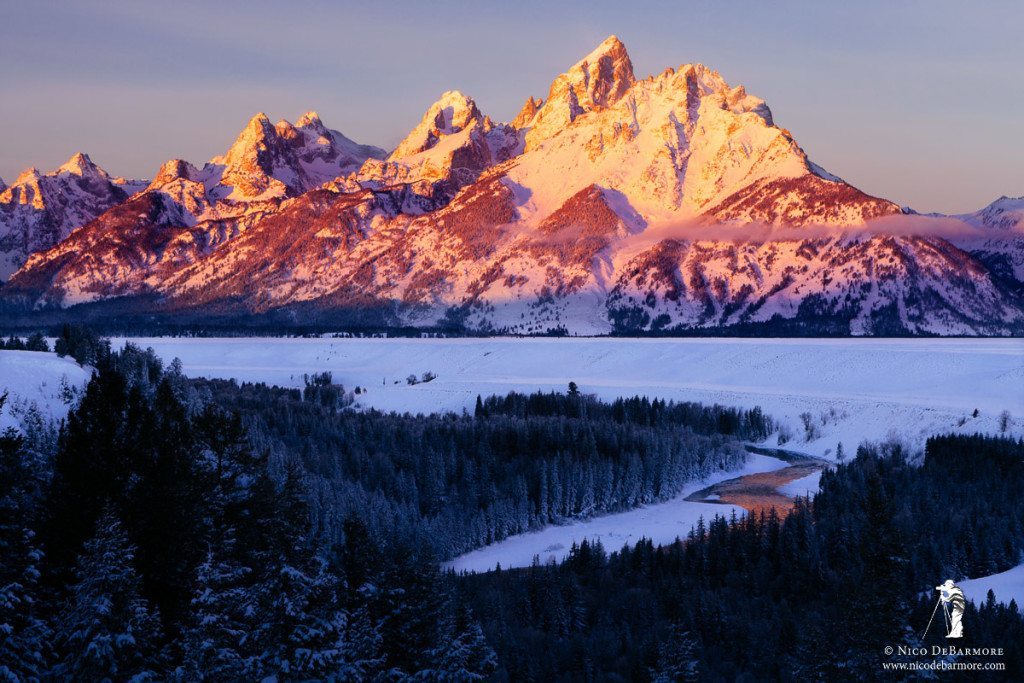

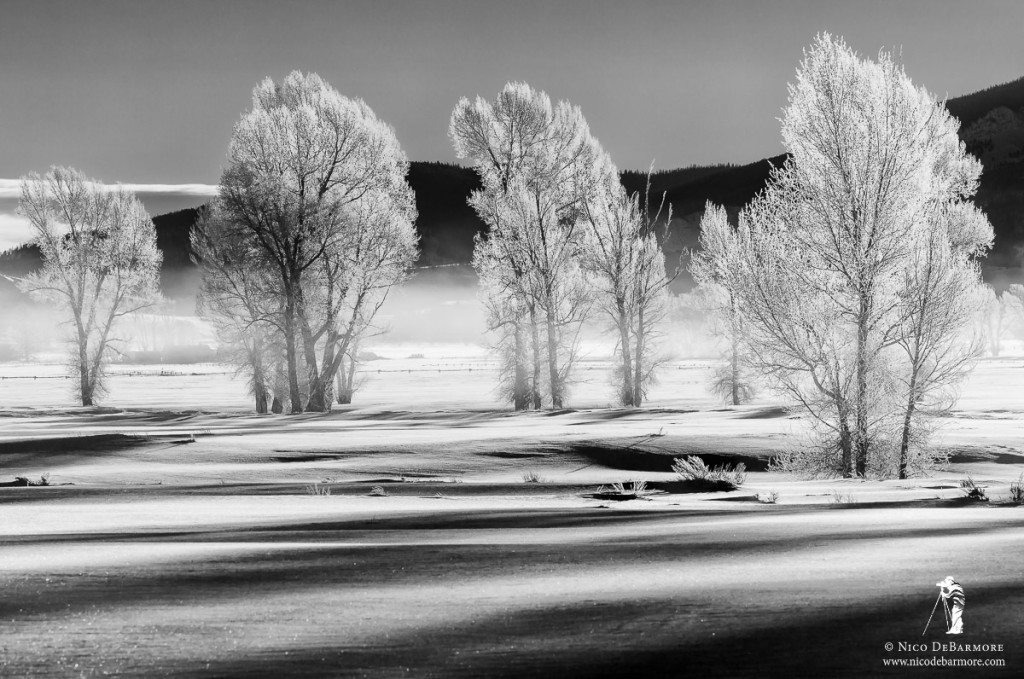
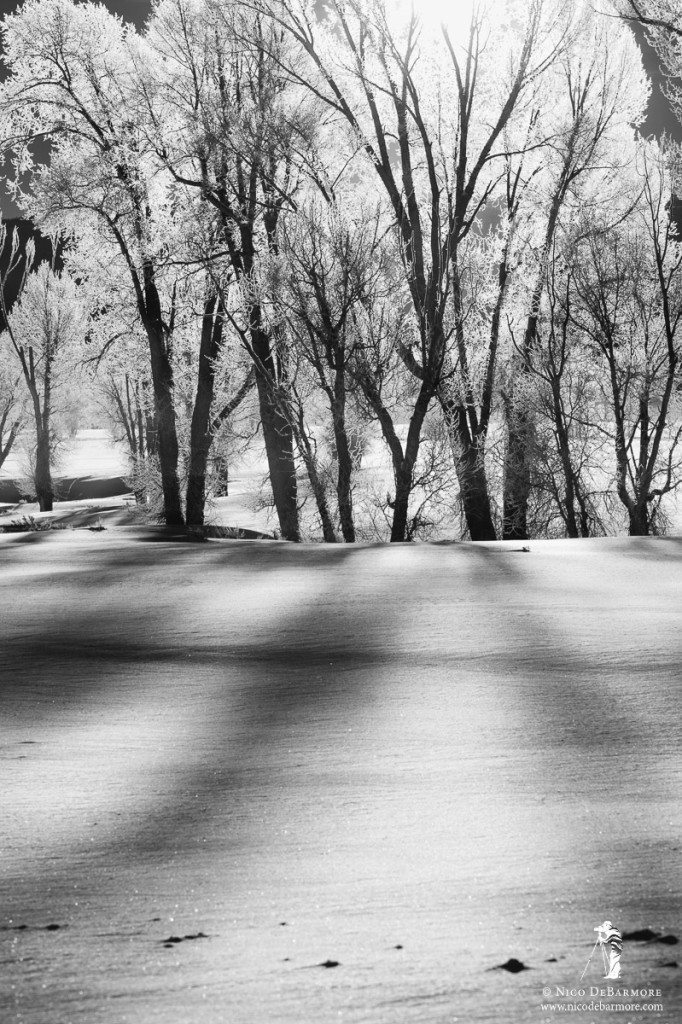

Leave a reply